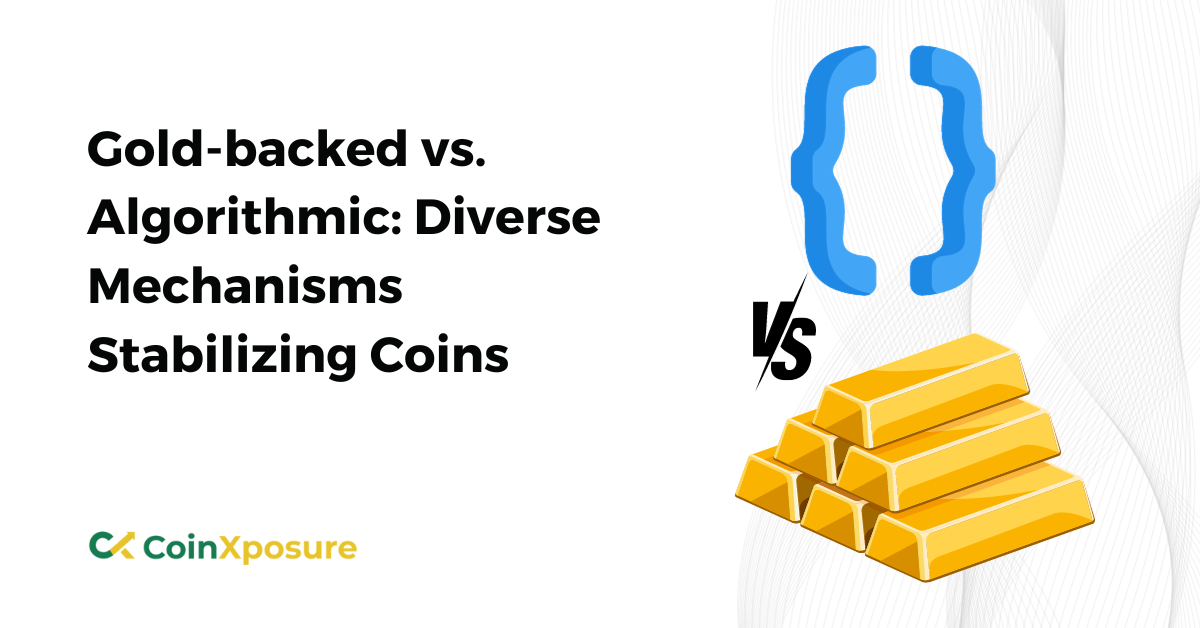In the dynamic landscape of cryptocurrencies, stability is a coveted attribute. Two distinct mechanisms have emerged to address this need: gold-backed and algorithmic stablecoins.
The former, tethered to the tangible value of gold, draws from a historical anchor of stability. On the other hand, algorithmic stablecoins leverage smart contracts and dynamic algorithms to maintain a steady value.
This exploration delves into the intricacies of these mechanisms, comparing their strengths, weaknesses, and roles in shaping the evolving cryptocurrency ecosystem.
Brief Overview of Gold-backed Stablecoins
Gold-backed stablecoins derive their stability from a tangible and time-tested asset – gold. These digital currencies are typically pegged to a specific amount of gold, providing a degree of intrinsic value.
The backing is often verified through audits and stored in secure vaults. Investors are drawn to gold-backed stablecoins for their potential to combine the stability associated with precious metals with the benefits of blockchain technology.
However, challenges such as scalability, reliance on centralized storage, and regulatory considerations underscore the nuanced dynamics of gold-backed stablecoins within the broader cryptocurrency landscape.
Brief Overview of Algorithmic Stablecoins
Algorithmic stablecoins operate differently, relying on smart contracts and algorithmic mechanisms to maintain a stable value. These digital currencies aim to adjust their supply dynamically based on market conditions, ensuring price stability without a direct peg to a physical asset like gold.
While offering flexibility and decentralization, algorithmic stablecoins face challenges such as susceptibility to market volatility, complex governance structures, and potential vulnerabilities in smart contract execution.
The allure lies in their ability to adapt to changing market dynamics, yet the intricacies of their algorithms necessitate careful examination to understand and navigate their unique stability mechanisms.
Mechanisms for Stability
The mechanisms for stability in gold-backed and algorithmic stablecoins differ in their approach to maintaining a consistent value.
Gold-backed Stablecoins
- Tangible Anchor: Stability is anchored to the value of gold, a precious metal with a long history of retaining value.
- Audits and Reserves: Regular audits verify the backing, ensuring transparency and trust among users.
- Reliance on Physical Storage: Stability depends on securing physical gold, introducing logistical considerations and potential vulnerabilities.
Algorithmic Stablecoins
- Smart Contracts: Stability is achieved through algorithmic adjustments, with smart contracts managing the coin’s supply dynamically.
- Market Dynamics: Algorithms respond to market forces, automatically adjusting supply to counteract fluctuations and stabilize the coin’s value.
- Decentralized Governance: Often governed by decentralized communities, introducing a different dimension of decision-making compared to centralized audits in gold-backed stablecoins.
Understanding these mechanisms provides insights into the strengths and challenges associated with each approach, contributing to the broader discourse on stablecoins and their role in the cryptocurrency landscape.
Market Adoption and Perception
Market adoption and perception play crucial roles in shaping the success of both gold-backed and algorithmic stablecoins.
Gold-backed Stablecoins
- Investor Sentiment: Attracts investors seeking stability through a tangible asset, especially those who value the historical reliability of gold.
- Perceived Security: Backing by a physical commodity may enhance trust and confidence among users.
- Regulatory Considerations: Compliance with regulations governing precious metals may influence market acceptance.
Algorithmic Stablecoins
- Crypto Community Reaction: Reception within the crypto community can be dynamic, with supporters lauding flexibility and decentralization, while skeptics may highlight risks associated with algorithmic governance.
- Innovation Appeal: Attracts users drawn to the innovative use of smart contracts and dynamic mechanisms for stability.
- Regulatory Uncertainty: Regulatory challenges may arise due to the complexity of algorithmic governance structures.
Navigating these factors is crucial for the widespread adoption of stablecoins, as both models seek acceptance in the broader financial landscape, each with its unique value propositions and considerations.
Future Trends and Challenges
Here are the future trends of both gold-backed stablecoin and algorithmic stablecoin:
Gold-backed Stablecoins
- Trends: Continued interest from traditional investors seeking a digital representation of gold. Integration with blockchain technology for enhanced transparency.
- Challenges: Addressing scalability issues, adapting to evolving regulatory frameworks, and finding ways to reconcile the physical nature of gold with the digital demands of blockchain.
Algorithmic Stablecoins
- Trends: Advancements in algorithmic governance, integration with decentralized finance (DeFi) ecosystems, and ongoing refinements to increase resilience to market fluctuations.
- Challenges: Navigating regulatory uncertainties, addressing vulnerabilities in smart contract execution, and finding effective decentralized governance models.
Common Challenges
- Regulatory Evolution: Both models face ongoing regulatory developments that may shape their adoption and operation.
- User Education: Enhancing users’ understanding of the mechanisms and risks associated with each stablecoin type.
- Market Dynamics: Adapting to the ever-changing dynamics of the cryptocurrency market and competition from other stablecoin models.
Anticipating and addressing these trends and challenges will be instrumental in shaping the future landscape for gold-backed and algorithmic stablecoins, influencing their adoption, and determining their roles within the broader financial ecosystem.
Conclusion
The comparison between gold-backed and algorithmic stablecoins underscores the diverse mechanisms employed to achieve stability in the ever-evolving cryptocurrency landscape.
Gold-backed Stablecoins draw on the historical reliability of gold, offering investors a tangible anchor for stability. However, challenges such as scalability, reliance on physical storage, and navigating regulatory landscapes highlight the nuanced nature of this approach.
On the other hand, Algorithmic Stablecoins leverage dynamic smart contracts to adapt to market forces, providing flexibility and decentralization. Yet, they face challenges related to market volatility, complex governance structures, and regulatory uncertainties.
In this diverse landscape, the coexistence of gold-backed and algorithmic stablecoins contributes to the resilience and adaptability of the broader digital asset ecosystem.
Investors, developers, and regulators alike will play pivotal roles in shaping the trajectory of these mechanisms, each offering a distinctive path to stability in the world of cryptocurrencies.












